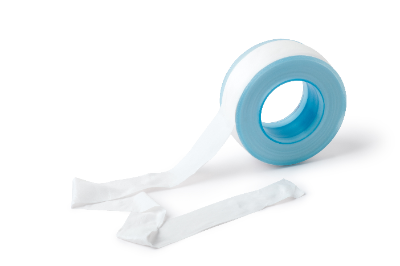What Is Sealing Tape?
 Sealing tape is a tape-type sealing material mainly made of Teflon.
Sealing tape is a tape-type sealing material mainly made of Teflon.
It is used to fill gaps in air and water pipes, hydraulic pipes, and other piping joints where gases and liquids pass through.
Uses of Sealing Tapes
Sealing tapes are used to wrap around the joints of gas, liquid, and hydraulic piping to carefully fill in gaps. It can increase airtightness and prevent leakage of substances through the piping.
The connecting parts have threaded cuts on each other and are connected by aligning both. Regardless of the material, it is very difficult to fully engage the threads, and it is common for a slight gap to occur.
Gases and liquids that pass through piping can easily pass through even a small gap, which can cause air leaks, water leaks, and oil leaks.
Characteristics of Sealing Tape
Advantages
The advantage of sealing tape is that simple plumbing connections can be easily repaired by an amateur. By selecting a durable product and using it in appropriate and suitable places, piping leaks can be prevented.
Disadvantages
Although weather-resistant sealing tapes are available, they will need to be repaired each time they are used outdoors due to deterioration over time. Leaks must be checked for during daily use.
Even indoors, if a leak starts in the toilet or kitchen area, it will interfere with the use of the room and require time to repair. Therefore, as in the outdoors, checks and repairs are essential.
Types of Sealing Tapes
There are many types of sealing tapes, varying in width and thickness. The basic width of sealing tape for water pipes is 8mm and 1.3cm. However, there are tapes for ducts that are almost 5cm wide.
Thickness varies from 0.1 to 1mm. Depending on the manufacturer, lengths of 1, 5, 10, and 15m are available. It can be easily torn off by hand, allowing one-handed work. -There are also heat- and weather-resistant ones that can withstand temperatures of around 100-260°C, chemical- and solvent-resistant ones and ones with excellent self-adhesion.
Teflon is the main material used, but there are also those made of high-strength polyester and those with polyester mesh for added strength.
How to Select a Sealing Tape
The width and thickness of sealing tape are fundamental. For beginners, a relatively wide width and some thickness are easier to handle.
For outdoor use, choose one that is weather resistant, taking into account exposure to rain and wind and differences in temperature between cold and hot. For duct use, those made of high-strength polyester or mixed polyester mesh are preferable to provide strength.
How to Use Sealing Tape
First, remove any dust or debris that may have gotten into the threads so that the sealing tape will not lose its adhesive strength. There are male and female threads in the piping connection. Start wrapping the sealing tape about 2 to 3 threads from the end of the male thread.
After a few wraps at the beginning, wrap the sealing tape so that it overlaps moderately toward the main body of the pipe. The key is to wind the sealing tape in the same direction as the threads so that it does not loosen.
If the tape is wound in the opposite direction, it will come off when the screw is connected. Also, if you start winding the tape while it is sticking out from the tip of the screw, a piece of tape may get mixed up in the pipe, which may cause a pipe blockage or machine failure.
Once connected, loosening the tape again will cause the sealing tape to lose its effectiveness, leading to leakage. Therefore, it is necessary to remove it again and re-wrap it with a new one. When removed, pieces of sealing tape may adhere to both sides of the screw. If not removed cleanly, they can easily cause problems. When rewinding anew, the old one must be removed before rewinding.